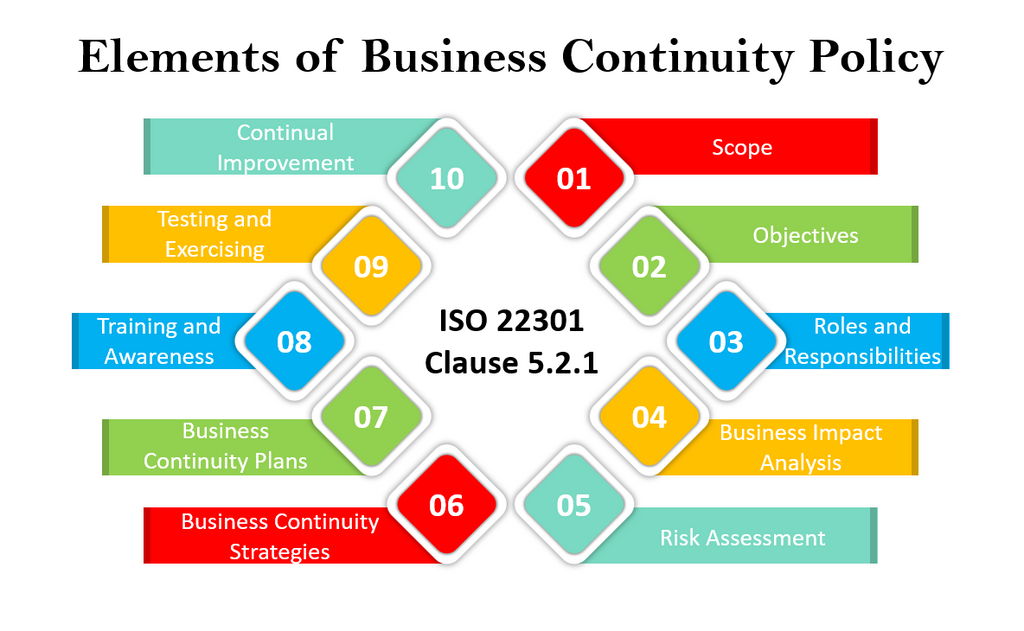ISO 22301 Clause 5.2.1 Establishing the Business Continuity Policy
Introduction
ISO 22301 is an international standard that outlines the requirements for a Business Continuity Management System (BCMS). Clause 5.2.1 of this standard specifically focuses on establishing the business continuity policy.
This policy is a critical component of an organization's BCMS as it provides a framework for the development and implementation of business continuity strategies, plans, and procedures.

Definition of Business Continuity Policy
The Business Continuity Policy is a formal document that outlines an organization's approach to business continuity management.
It provides a framework for the development and implementation of strategies, plans, and procedures to ensure that an organization can continue to operate during and after a disruption. The policy establishes the organization's commitment to business continuity and sets the direction for the development and maintenance of a BCMS.
Importance of Business Continuity Policy
The Business Continuity Policy is essential for any organization to effectively manage disruptions and maintain operations.
Here are some key reasons why the policy is important:
- It provides a clear understanding of the organization's commitment to business continuity management.
- It ensures that all stakeholders are aware of their roles and responsibilities during a disruption.
- It establishes the framework for the development and implementation of business continuity strategies, plans, and procedures.
- It helps to ensure that the organization can maintain critical business functions and minimize the impact of disruptions.
- It provides a basis for continual improvement of the BCMS.
Elements of Business Continuity Policy
The following elements should be included in the Business Continuity Policy:
1. Scope: The scope of the policy should define the business units, processes, and systems that are covered by the BCMS.
2. Objectives: The policy should include clear objectives for the BCMS, which should be aligned with the organization's overall goals and objectives.
3. Roles and Responsibilities: The policy should clearly define the roles and responsibilities of all stakeholders involved in the development, implementation, and maintenance of the BCMS.
4. Business Impact Analysis: The policy should require the organization to conduct a Business Impact Analysis (BIA) to identify critical business functions, resources, and dependencies.
5. Risk Assessment: The policy should require the organization to conduct a risk assessment to identify potential threats and vulnerabilities.
6. Business Continuity Strategies: The policy should establish the framework for the development of business continuity strategies to minimize the impact of disruptions.
7. Business Continuity Plans: The policy should require the development of business continuity plans to ensure that critical business functions can continue during a disruption.
8. Training and Awareness: The policy should require training and awareness programs to ensure that all stakeholders understand their roles and responsibilities.
9. Testing and Exercising: The policy should require the testing and exercising of the BCMS to ensure its effectiveness.
10. Continual Improvement: The policy should require continual improvement of the BCMS through regular review and update processes.
Implementing Business Continuity Policy
Here are the steps to implement a Business Continuity Policy:
- Communication and Awareness: Effective communication and awareness are crucial to the successful implementation of the Business Continuity Policy. It is important to ensure that all stakeholders, including employees, management, business partners, and customers, understand the policy and their roles and responsibilities during a disruption.
- Policy Implementation: Policy implementation involves putting the strategies, plans, and procedures into practice to ensure that the organization can continue critical operations during a disruption. This involves assigning roles and responsibilities, developing procedures, establishing communication protocols, training employees, and regularly testing and reviewing the procedures.
- Monitoring and Measuring: Monitoring and measuring the effectiveness of the Business Continuity Policy is critical to ensuring that the policy is achieving its objectives. This involves establishing metrics to measure the effectiveness of the policy, regularly reviewing the metrics, and making necessary adjustments to improve the policy.
Reviewing and Updating Business Continuity Policy
Reviewing and updating a Business Continuity Policy is a crucial step in ensuring its effectiveness. This involves periodically reviewing the policy to identify gaps or weaknesses, updating the policy to address these issues, communicating the changes to stakeholders, testing the updated policy, and establishing a schedule for future reviews.
Regularly reviewing and updating the policy is necessary to ensure its relevance and effectiveness in the face of changing circumstances.
Conclusion
In conclusion, developing and implementing a Business Continuity Policy is essential for ensuring the continuity of critical operations during disruptions. Regularly reviewing and updating the policy is necessary to ensure its effectiveness in the face of changing circumstances.



